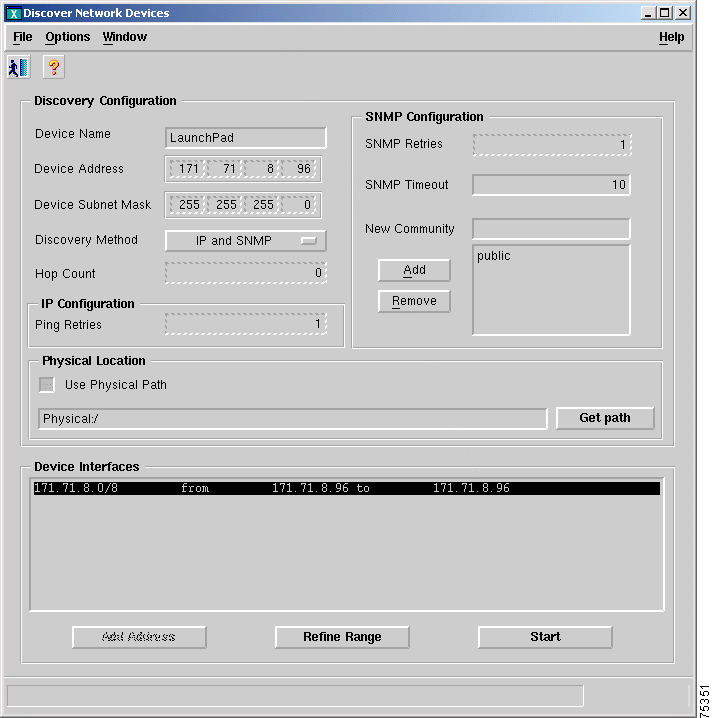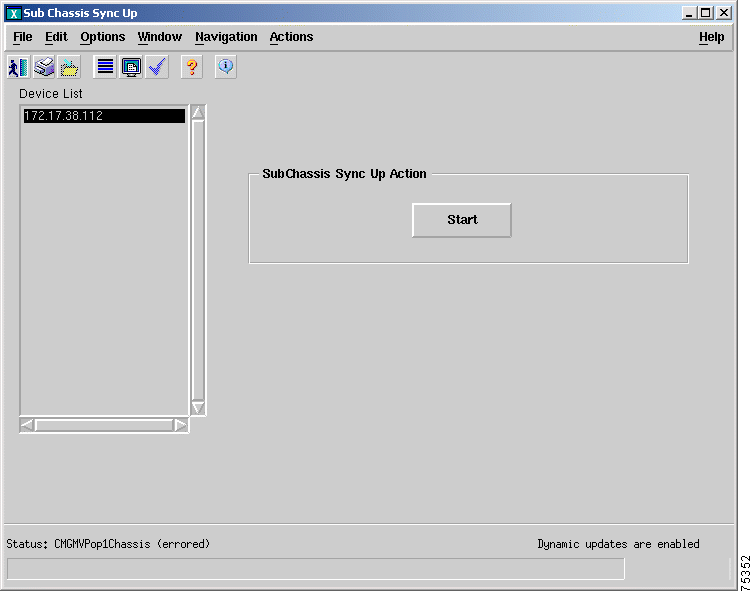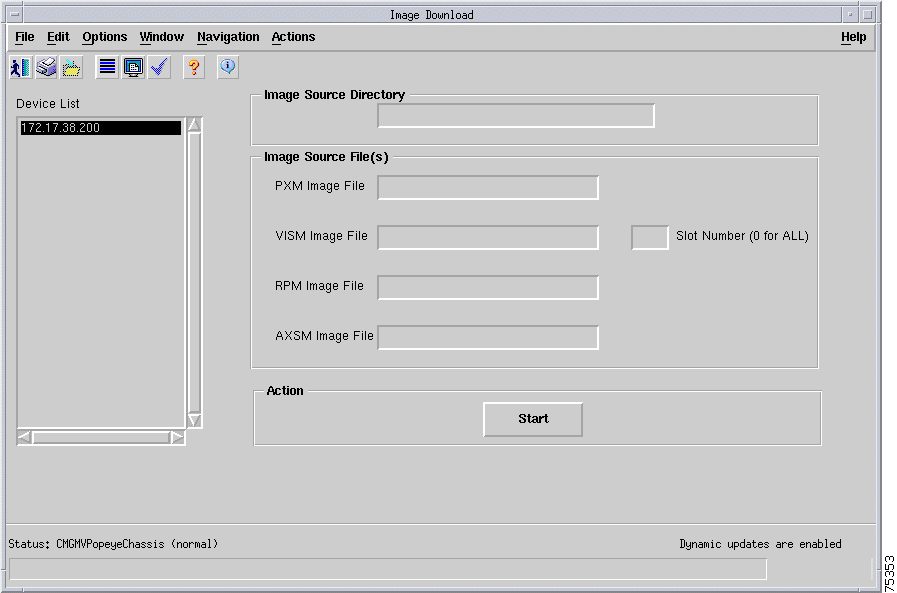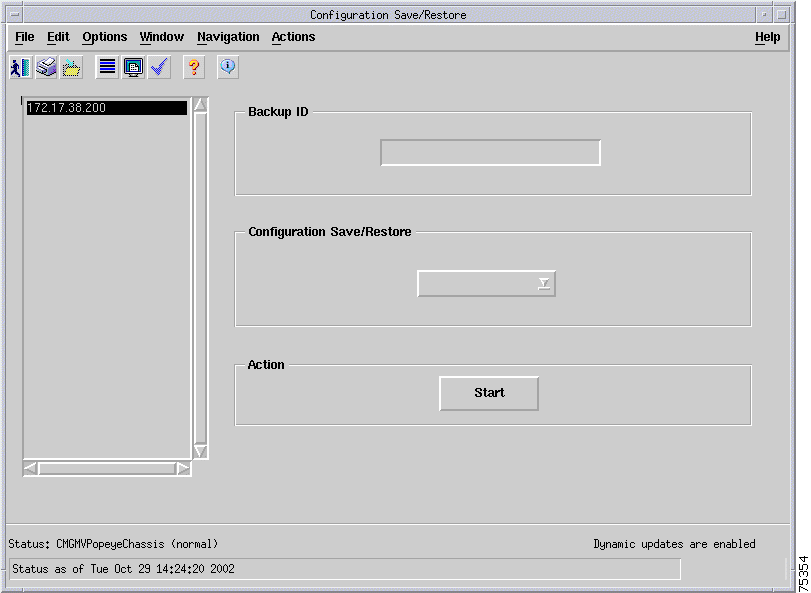|
|

Cisco MGM automatically discovers network elements and displays them on the Map Viewer screen. From this screen you can view operational status and navigate to screens that support Cisco MGX 8000 Series Carrier Voice Gateway configuration and software upgrades.
Cisco MGM organizes MGX 8000 Series Carrier Voice Gateways by site. A site contains all gateways that have the same value for the standard SNMP sysLocation object. If a gateway does not have a value set for sysLocation, Cisco MGM includes the gateway under CMGM_Site_default. If a gateway does have a value set for sysLocation, Cisco MGM includes the gateway under the site titled CMGM_Site_<sysLocation value>.
 |
Note You can only change the gateway sysLocation value using an SNMP tool. You can not change the gateway sysLocation value with Cisco MGM or the MGX command line interface. |
 |
Note A Cisco MGM site remains in the system even if you delete all its gateways. Use Deployment > Delete Object to remove an empty site. |
Automatic discovery occurs in two phases:
1. Automatic discovery of Cisco MGX 8000 Series gateways and associated media gateway controllers in a subnet.
2. Subchassis synchronization of MGX 8000 Series subcomponents.
You initiate automatic discovery from the Cisco MGM GUI by specifying the desired IP address range. Cisco MGM automatically discovers MGX 8000 Series gateways and media gateway controllers with IP addresses that fall within this range. For more information, see the "Cisco MGM Community String Configuration" section.
When you initiate automatic discovery, Cisco EMF pings each IP address in the given range. If a response is received, Cisco EMF initiates an SNMP GET request for the enterprise object id (OID). If the OID matches any of the predefined Cisco EMF class mappings, an object of that class is created and displayed. If no match is found, the process creates a generic SNMP device under the physical level of the hierarchy. You can't manage these generic devices.
To discover network elements, follow these steps:
<CEMFROOT>/cemf/bin/cemf session
Step 2 Log on to Cisco EMF. The Launchpad screen opens.
Step 3 Click the Discovery button. The Discover Network Devices screen opens. (See Figure 4-1.)

Step 4 Configure the discovery parameters:
| Parameter | Description |
|---|---|
Device Name | Fixed as LaunchPad. |
Device Address | The IP address from which to start the discovery process, expressed in standard dot notation. |
Discovery Method | The method of discovery, IP, SNMP, or IP and SNMP. Specify SNMP to discover all components. |
Hop Count | The number of routing hops to allow. Default: 0. |
Ping Retries | The number of times to ping each address in the range. Default: 1. |
SNMP Retries | The number of SNMP retries to allow. Default: 1. |
SNMP Timeout | The timeout of SNMP tries. Default: 10. |
New Community | Add or remove SNMP communities. |
Physical Location | The physical path in the Cisco EMF hierarchy. Click Use Physical Path to use an existing path. |
Interface Attributes | The subnet and range of IP addresses to search. Double click to specify or change the range. |
Step 5 Click Start.
Step 6 At the end of the discovery process, click Close.
Subchassis synchronization searches for entities within an Cisco MGX 8000 Series gateway and displays them on the Cisco MGM user interface. The subchassis synchronization process is automatically invoked after auto discovery. The subchassis synchronization process inspects SNMP MIBs for the following configurable objects:
Cisco MGM uses the read-write community string for subchassis synchronization. The default read-write community string is POPEYE. You can change the read-write community string in the cmgmvCtrlUserData.ini file. For more information about the cmgmvCtlrUserData.ini file, refer to "Cisco MGM Server Configuration Files."
When the subchassis synchronization process is complete, Cisco MGM adds the subchassis components to the site hierarchy display. You can expand the hierarchy to display cards and profiles by clicking the + sign next to the Cisco MGX 8000 Series icons. Similarly, you can expand the hierarchy to display lines by clicking the + sign next to each card. A number next to the object indicates the number of contained cards or lines.
You can manually invoke the subchassis synchronization process from the Cisco EMF menu bar. The subchassis discovery process retrieves subchassis component information from each Cisco MGX 8000 Series gateway and displays corresponding objects on the Cisco MGM user interface.
To synchronize subchassis components, follow these steps:
Step 2 Click the Viewer button. The MapViewer screen opens.
Step 3 Click the tree of objects to display the list of sites and nodes.
Step 4 Right-click the desired site or node and select Open SubChassis Sync Up Dialog. The Subchassis Sync Up window opens. (See Figure 4-2.)

Step 5 Select the desired nodes from the list.
Step 6 Click Start.
The system synchronizes the user display with subchassis components.
Periodic subchassis synchronization discovers the subchassis components of each node without user intervention. This background task runs on a fixed interval, once every 24 hours, rather than at a fixed time. Therefore, the time of day when this task runs depends on the last time the Cisco MGM controller was initialized.
The software download feature facilitates the downloading of runtime and backup boot image files to selected gateways. Downloading software does not automatically activate it; the selected gateway continues to operate on current software until you perform the upgrade procedure. When you are downloading software images, Cisco MGM accepts a list of nodes and the fully qualified name of the image or configuration file. After download, the system reports successes and failures by node name.
To download software, follow these steps:
Step 2 Click the Viewer button. The Map Viewer screen opens.
Step 3 Click the tree of objects to display the list of sites and nodes.
Step 4 Right-click the icon for the desired site or chassis and select Image DownLoad. The Image Download screen opens. (See Figure 4-3.)

Step 5 Enter the file information shown in Table 4-1.
 |
Caution Cisco MGM does not check for a match between the device and the image file entered. If you select an incorrect type of image for the device, the device does not function properly. Before installing images on your managed devices, check their compatibility by contacting the Cisco Technical Assistance Center. |
| Field | Description | Usage |
|---|---|---|
Device | List of devices | Select the device objects for software download. |
Image Source Directory | Text field for entering the directory name for the image source file(s) | Enter the source directory for the image file(s). |
Image Source File(s) | Image files for PXM1, VISM, VISM-PR, and RPM-PR card | Enter the full image filename(s) for the corresponding card types, to download to the device. The detailed description of each text field in the Image Source File(s) frame is listed below: |
| PXM1 source file | Enter the PXM1 image file name. To upgrade the PXM1 Flash backup boot image: 1. Use the Cisco MGM image download dialog to download the PXM1 boot image to the device. 2. On the Cisco MGX8000 Series PXM1 execute the install bt <version> command. To upgrade the PXM1 runtime software image: 1. Use the Cisco MGM image download dialog to download the PXM1 runtime image to the device. Note For the PXM1 runtime image, another supporting file named ComMat.dat is automatically downloaded to the device. Cisco MGM looks for this file in the same directory as the PXM1 runtime image. Make sure the compatible ComMat.dat file is located in this directory. 2. On the Cisco MGX 8000 Series PXM1, execute the install <version> command. Answer Yes to the MGX 8000 Series prompt (if there is no redundant PXM1). For more information about PXM upgrade procedures, refer to the Software Release Notes Cisco WAN MGX 8850, 8230, and 8250 Software. |
| Enter the VISM or VISM-PR image file name. To upgrade the VISM or VISM-PR Flash backup boot image: 1. Use the Cisco MGM image download dialog to download the VISM boot image to the device. 2. On the Cisco MGX 8000 Series VISM execute the install bt sm <version> command. To upgrade the VISM or VISM-PR runtime software image: 1. Use the Cisco MGM image download dialog to download the VISM runtime image to the device. 2. On the Cisco MGX 8000 Series VISM, execute the install sm <version> command. For more information about VISM upgrade procedures, refer to the Release Notes for Cisco Voice Interworking Service Module Release. | |
| RPM-PR Source File | Enter the RPM-PR image file name. For more information about RPM-PR upgrade procedures, refer to the RPM-PR Install & Configuration Guide. |
Slot Number | Integer field to enter slot number | Specify the card slot number for which you want to download the software image. If you enter 0 in the Slot Number field or the Slot Number field is empty, the image is downloaded to all cards on the device. |
Step 6 Click Start. An action result dialog appears with status of the image download action for the selected devices.
Step 7 Repeat steps 1 to 7 for other card images.
You can back up and restore network card and chassis configurations using the Cisco MGM configuration save and restore feature. Files are saved one level above your <CEMFROOT> directory with the following file naming convention:
<CEMFROOT>/../ConfigData/<IPADDRESS>_<BACKUPID>/<NODENAME>.ZIP
 |
Note You can change the default directory by editing the CMGMVConfigSaveDir setting in <CEMFROOT>/config/init/cmgmCtlrUserData.ini. |
The Cisco MGM configuration save function logs on to the selected device, invokes a saveallcnf command to generate the configuration file, and sends a tftp get command to transfer the device configuration file to your Cisco MGM workstation.
To save a device configuration file, follow these steps:
Step 2 Click the Viewer button. The Map Viewer screen opens.
Step 3 Click the tree of objects to display the list of sites and nodes.
Step 4 Right-click the icon for the desired site and click Configuration Save/Restore Dialog. The Configuration Save/Restore Dialog window opens. (See Figure 4-4.)

Step 5 Enter the required information. (See Table 4-2.)
 |
Note The default pull-down menus are blank. You must click on each pull-down menu to reveal the available options. |
| Field | Description | Usage |
|---|---|---|
Device List | List of devices | Select the device objects you want to save/restore. You can select multiple devices at the same time. |
Backup | Text field to enter the backup ID. | You can save multiple versions of the configuration files in different directories if a different backup ID is used each time. |
Login | Text field to enter the login ID for the device. | — |
Password | Text field to enter password for the device. | — |
Configuration Save/Restore | Drop down menu to select the save or restore action. | — |
Step 6 Click Start.
Step 7 An Action Result Dialog appears with the status of the Configuration Save/Restore action on the selected devices.
 |
Note The Configuration Restore action transfers only the configuration file from the Cisco MGM workstation to the device hard disk. To restore all the configuration files, telnet to the device and use the CLI restoreallcnf command. |
The Cisco MGM configuration restore function logs on to the selected device, and sends a tftp put command to transfer the configuration file from your Cisco MGM workstation to the selected device.
To restore a device configuration file, follow these steps:
Step 2 Click the Viewer button. The Map Viewer screen opens.
Step 3 Click the tree of objects to display the list of sites and nodes.
Step 4 Right-click the icon for the desired site and click Configuration Save/Restore Dialog. The Configuration Save/Restore window opens. (See Figure 4-4.)
Step 5 Enter the required information. (See Table 4-2.)
 |
Note The default pull-down menus are blank. You must click on each pull-down menu to reveal the available options. |
Step 6 Click Start.
Step 7 An Action Result Dialog appears with the status of the Configuration Save/Restore action on the selected devices.
![]()
![]()
![]()
![]()
![]()
![]()
![]()
![]()
Posted: Thu Aug 8 22:10:14 PDT 2002
All contents are Copyright © 1992--2002 Cisco Systems, Inc. All rights reserved.
Important Notices and Privacy Statement.